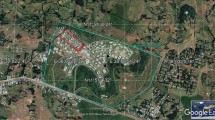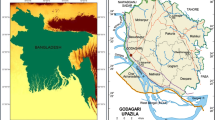Abstract
Rainwater harvesting structures have been proved as one of the best options to conserve runoff in hard rock areas in India. Volume of rainwater conserved in a structure depends on the design dimension of the structures, soil type, climate, and land topography. These structures also act as groundwater recharge means if constructed at an appropriate location. Direct quantification of amount of water recharged from the structures in field condition is not feasible, but there are few indirect methods to quantify important water budget parameters. In this paper, water balance approach was used to estimate all inflow to the structure and outflow from the rainwater harvesting structures located in Bargharianala microwatershed in Nayagarh district of Odisha (India). Rainfall and runoff to the structures were inflow components, and evaporation, seepage/percolation losses, and extraction for irrigation from the structures were the outflow components. Monthly water level change was measured from the water harvesting structures and the changes in water level were used to determine the effect of recharge/subsurface flow. Seepage and percolation rate was estimated based on the piezometric observations. Result showed that annually recharge from structure with 0.38 ha m capacity was only 0.03 m during initial construction of the structure which further increased to 0.25 m after subsequent years. For 0.5 to 0.75 ha m structure, the recharge amount varied from 0.318 to 0.18 m with average of 0.25 m. In case of structure of 0.2 ha m capacity, with a recharge well within the structure, recharge was increased up to 0.86 m. The impact of these structures was observed up to 300 m areal extents covering the area of influence of 15 ha command area in hard rock areas of Odisha. The water table depth in dug wells located within the command area raises up to 1 m during pre-monsoon season.








Similar content being viewed by others
References
Ahmad I (2013) Investigating of potential water harvesting sites at Potohar using modeling approach. Pak J Agric Sci 50(4):723–729
Al-Adamat R (2008) GIS as a decision support system for siting water harvesting ponds in the Basalt Aquifer/NEJordan. J Environ Assess Policy Manag 10(02):189–206
Al-Adamat R, AlAyyash S, Al-Amoush H, Al-Meshan O, Rawajfih Z, Shdeifat A, Al-Farajat M (2012) The combination of indigenous knowledge and geo- informatics for water harvesting sitting in the Jordanian Badia. J Geogr Inf Syst 4:366–376
Ammar A, Riksen M, Mohamed O, Coen R (2016) Identification of suitable sites for rain water harvesting structures in arid and semi-arid regions: a review. Int Soil Water Conserv Res 4:108–120
Balkhair KS (2002) Aquifer parameters determination for large diameter wells using neural network approach. J Hydrol 265:118–128
Bhagwat TN, Hegde VS, Shetty A (2018) Application of remote sensing and GIS for identification of potential ground water recharge sites in Semi-arid regions of Hard-rock terrain, in north Karnataka, South India. Sustain Water Resour Manag 4:1063–1076. https://doi.org/10.1007/s40899-018-0244-6
Bhatt G (2012) A distributed hydrologic modeling system: framework for discovery and management of water resources. Doctor of Philosophy, The Pennsylvania State University
Contreras SM, Sandoval TS, Tejada SQ (2013) Rainwater harvesting, its prospects and challenges in the uplands of Talugtog, Nueva Ecija, Philippines. Int Soil Water Conserv Res 1(3):56–67
Critchley W, Siegert K, Chapman C (1991) Water harvesting—a manual for the design and construction of water harvesting schemes for plant production: AGL/MISC/17/91. Food and Agriculture Organization, Rome
De Winnaar G, Jewitt GPW, Horan M (2007) A GIS-based approach for identifying potential runoff harvesting sites in the Thukela River basin, South Africa. Phys Chem Earth 32:1058–1067
Guerra LC, Watson PG, Bhuiyan SI (1990) Hydrological analysis of farm reservoirs in rainfed areas. Agric Water Manag 17(4):351–366
Han M (2006) Revival of rainwater harvesting and management in Asia and the Pacific sustainable infrastructure in Asia. Overview and proceedings, pp 109–118
IPCC (2014) Climate Change 2014: impacts, adaptation and vulnerability technical summary. Inter-governmental Panel on Climate Change, Geneva
Kumar CP (1996) Assessment of groundwater potential. In: Kumar CP (ed) All India seminar on small watershed. Indian Association of Hydrologists, Calcutta
Mahalle YR, Dahiwali RA (2014) Study of evaporation and seepage losses from farm pond in saline area. Int J Agric Eng 7(2):402–409
Pande BC, Khadri SFR, Moharir Kanak N, Patode RS (2018) Assessment of groundwater potential zonation of Mahesh River basin Akola and Buldhana districts, Maharashtra, India using remote sensing and GIS techniques. Sustain Water Resour Manag 4(4):965–979
Prinz D, Oweis T, Oberle A (1998) Rain water harvesting for dry land agri- culture-developing a methodology based on remote sensing and GIS. In Proceedings of XIII international congress agricultural engineering, ANAFD, Rabat, Morocco, p 12
Rao KV, Venkateswarlu B, Sahrawat KL, Wani SP, Mishra PK, Dixit S, Reddy KS, Kumar M, Saikia US (eds) (2009) Proceedings of national workshop-cum-brain storming. 21–22 April, CRIDA, Hyderabad, India.
Rattray GW (2017) Estimated seepage rates from selected ditches, ponds, and lakes at the Camas National Wildlife Refuge, eastern Idaho. J Environ Manag 203(Pt 1):578–591. https://doi.org/10.1016/j.jenvman.2017.02.063
Sekar I, Randhir TO (2007) Spatial assessment of conjunctive water harvesting potential in watershed systems. J Hydrol 334(1):39–52
Shalander K, Thiagarajah R, Ramarao CA, Srinivasa RC, Anthony W (2016) Farm level rainwater harvesting across different agro climatic regionsof India: assessing performance and its determinants. Agric Water Manag 176:55–66
Singh VS (2000) Well storage effect during pumping tests in an aquifer of low permeability. Hydrol Sci J 45(4):589–594
Soil Conservation Service (SCS) (1964) National engineering handbook. Section 4, Hydrology. Department of Agriculture, Washington
Soil Conservation Service (SCS) (1972) National engineering handbook. Section 4, Hydrology. Department of Agriculture, Washington
Acknowledgements
This study was conducted as Institute funded project from Indian Council of Agricultural Research.
Author information
Authors and Affiliations
Corresponding author
Additional information
Publisher's Note
Springer Nature remains neutral with regard to jurisdictional claims in published maps and institutional affiliations.
Rights and permissions
About this article
Cite this article
Sethi, R.R., Ambast, S.K., Panda, B. et al. Quantification of recharge from the rainwater harvesting structures—a case study in hard rock area of Odisha (India). Sustain. Water Resour. Manag. 6, 84 (2020). https://doi.org/10.1007/s40899-020-00443-2
Received:
Accepted:
Published:
DOI: https://doi.org/10.1007/s40899-020-00443-2




